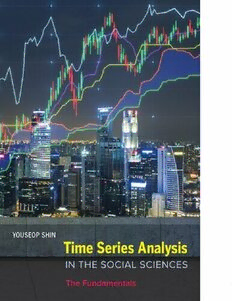
Time Series Analysis in the Social Sciences The Fundamentals PDF
Preview Time Series Analysis in the Social Sciences The Fundamentals
Time Series Analysis in the Social Sciences Time Series Analysis in the Social Sciences THE FUNDAMENTALS Youseop Shin UNIVERSITY OF CALIFORNIA PRESS University of California Press, one of the most distinguished university presses in the United States, enriches lives around the world by advancing scholarship in the humanities, social sciences, and natural sciences. Its activities are supported by the UC Press Foundation and by philanthropic contributions from individuals and institutions. For more information, visit www.ucpress.edu. University of California Press Oakland, California © 2017 by Youseop Shin Library of Congress Cataloging-in-Publication Data Names: Shin, Youseop, 1964- author. Title: Time series analysis in the social sciences : the fundamentals / Youseop Shin. Description: Oakland, California : University of California Press, [2017] | Includes bibliographical references and index. Identifiers: LCCN 2016022158 (print) | LCCN 2016023292 (ebook) | ISBN 9780520293168 (cloth : alk. paper) | ISBN 9780520293175 (pbk. : alk. paper) | ISBN 9780520966383 (ebook) Subjects: LCSH: Time-series analysis. | Social sciences —Statistical methods. Classification: LCC QA280 .S55 2017 (print) | LCC QA280 (ebook) | DDC 519.5/5—dc23 LC record available at https://lccn.loc.gov/2016022158 26 25 24 23 22 21 20 19 18 17 10 9 8 7 6 5 4 3 2 1 To my parents, Dongjoon and Hangil, my wife, Jungwon, and my son, Lucky Boy, Jaeho CONTENTS Preface 1 Time Series Analysis in the Social Sciences 2 Modeling (1) Preliminary Definition (2) Preparing for Analysis (3) Seasonal Components and Trend (4) Systematic Patterns of Residuals (5) Fitting the Residuals (6) Further Reading 3 Diagnostics (1) Residual Assumptions (2) The Case of Monthly Violent Crime Rates, 1983–1992 (3) Further Reading 4 Forecasting (1) How to Forecast Values (2) Measuring the Accuracy of Time Series Models (3) The Case of Monthly Violent Crime Rates, 1983–1992 (4) Further Reading 5 Smoothing (1) Moving Average Smoothing (2) Exponential Smoothing (3) The Case of Monthly Violent Crime Rates, 1983–1992 (4) Further Reading 6 Time Series Analysis with Two or More Time Series (1) Correlation and Regression Analysis (2) Prewhitening (3) Multiple Time Series Analysis with Lagged Variables (4) Diagnostics (5) Further Reading 7 Time Series Analysis as an Impact Analysis Method (1) Interrupted Time Series Analysis (2) The Case of Monthly Violent Crime Rates, 1985–2004 (3) Further Reading Appendices 1. Links to Online Time Series Analysis Program Manuals 2. U.S. Monthly Violent Crime Rates, 1983–2004 3. Data Resources for Social Science Time Series Analysis 4. Statistical Tables Notes References Index PREFACE In the social sciences, it generally takes longer to collect temporal data than to collect cross-sectional data. In addition, it is generally hard to obtain observations for as many time points as are needed for good time series analysis. For these reasons, time series analysis is employed less frequently than cross-sectional analysis. Time series analysis, however, can serve special purposes. For example, we may identify and explain a systematic temporal pattern of a variable, even when the variable does not appear to change significantly over time. We can explain and predict the dependent variable from the observations of its past behavior, instead of relying on a limited set of independent variables. Thereby, any independent variables that may influence the dependent variable are taken into account, and we can avoid threats to external validity of our explanations of the dependent variable. In multiple time series analysis, we can reflect any excluded important independent variables in a lagged dependent variable on the right-hand side of the equation. We can estimate how long an estimated effect of an independent variable on the dependent variable persists. By comparing two trends before and after a program is implemented, we can test whether the program brings about the expected effect. To employ an appropriate time series analysis when necessary, social scientists and professionals, such as policymakers, campaign strategists, securities analysts, and realtors, should first understand what time series analysis is, and what we can do with it, and how. There are many books on time series analysis. However, there are no books that carefully and gently explain time series analysis for social scientists and professionals. Most books on time series analysis contain sophisticated mathematical materials, such as matrixes and integral calculus, which most social scientists and professionals do not have to understand for their research and practice. The purpose of this book is to provide practical, easy-to- understand guidelines for time series analysis that are suitable for social scientists and professionals. I intend to make this book a primer for social scientists and professionals which helps them learn and utilize time series analysis without having to understand extraordinary mathematical materials, which they are not likely to use when they employ time series analysis as part of their research and practice. Knowledge of regression analysis, that is, how to estimate a slope and what are the properties of residuals, can be helpful in understanding this book.
